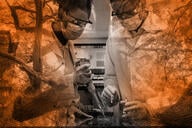You have /5 articles left.
Sign up for a free account or log in.

Artur/iStock/Getty Images Plus
We have entered the era of the lecturer in higher education. According to the American Association of University Professors, roughly 68 percent of all faculty positions in fall 2023 were off the tenure track. But despite their enormous presence on college campuses, contingent faculty rarely participate in the full range of activities popularly associated with their tenure-track colleagues. This is especially true when it comes to publishing academic articles and monographs.
What explains this drop-off in research and writing? Partly, it is because adjuncts lack the kind of departmental support that makes traditional publication achievable for new tenure-track hires: senior faculty mentoring networks, course releases and class offerings that align with their existing knowledge and expertise. Additionally, heavy teaching loads make the research, travel and writing required for such publications challenging.
In fact, for many of us lecturers, the yearning to publish never dies. But prioritizing a research and writing agenda as a lecturer—by burning the candle at both ends—is a labor gamble for us. Time spent revising one’s dissertation for publication or writing books or articles in hopes of a tenure-track offer, esteem among colleagues or simply for the love of the material is time-consuming and—most importantly—uncompensated labor. These side hustles do not directly translate to job security or promotion for adjunct instructors whose prime occupational directive is simply to teach.
There are, however, academic writing projects that would serve this vast pool of instructors. Self-published pedagogical aids (for example, sourcebooks for those who teach history like me) focused on the classes they teach would tap into their academic interests and training, align with their employment rationale as educators, and, therefore, contribute to their job security and promotion. And while faculty of any stripe may benefit from producing pedagogical materials for their classes, I especially have the needs of lecturers in mind for this essay.
The topic of developing self-produced works for instruction raises provocative questions about the boundaries of academic publication. What exactly qualifies an instructor to produce educational materials for their classes? Should faculty be compensated for doing so? And how should such publications be received by colleagues? A complete treatment of these questions is beyond the scope of this essay. However, I will begin here a conversation about the potential of self-published materials, and the purpose and limits of academic publication, that I hope others will join.
What exactly does it mean to self-publish a text? While “self-publish” is the common phrase used to describe the types of books created by print-on-demand platforms such as Kindle Direct Publishing (KDP) and Lulu, they are not published in the traditional academic sense. These products are more accurately described as “self-produced,” which is the term I will mostly use throughout this essay. They are best thought of as pedagogical aids, and they differ from a traditional academic publication in important ways. Indeed, I want to dispel through this essay the fear that self-produced projects encroach upon scholarly publications or would somehow blur the line as to what constitutes a scholarly publication.
Academic publications contribute new ideas or interpretations to existing fields of knowledge. Academic publishers make these goals possible by overseeing the peer-review process of a text, negotiating numerous editorial changes between reviewers and the author, managing the material production of the book, and advertising the publication to the public and, especially, university libraries. This labor represents a substantial investment in time and money for everyone involved.
The kind of self-produced pedagogical aids I have in mind, on the other hand, are primarily extensions of course preparation. For example, I now realize that I was already engaged in making such a work, a history sourcebook for one of the courses I teach, long before I even conceived of it as a project just by revising the content of my courses each semester.
When I selected some sources from my assigned big-market history reader and passed over others because they were irrelevant to my course’s learning goals, I was already making a sourcebook. Each time I supplemented my assigned history reader with additional sources because they fit the learning goals of my course better, I was already making a sourcebook. When I translated a sermon from Latin to English for my course because it communicated the point I made in my lecture on religious visionaries, I was already making a sourcebook. When I provided my students with additional historical context on the sources we were using and constructed study questions to emphasize the goals of my lectures, I was already … well, you get the point. Except for translation work, these are all instructional activities faculty routinely engage in when perfecting the courses they teach. If you have taught the same introductory course over and over, without knowing it you have likely already begun down the path of creating your own pedagogical aid for your course.
The goal of self-produced aids is also different from scholarly publications. While self-produced content designed to meet the needs of a specific course may contribute fresh content or interpretations in the ways that scholarly publications do, that is not generally its goal, nor is it the goal of undergraduate instruction more broadly. The point of undergraduate courses, especially introductory ones that lecturers often teach, is to synthesize the scholarship of a field and present it to students in clear and compelling ways. Thus, the pedagogical aids developed to support such courses naturally align with this goal.
Since self-produced sourcebooks are not designed to meet the same goal as scholarly publications, they are not in competition with them. And yet, they provide an important intellectual and pedagogical outlet to instructors whose careers mainly entail teaching. The enormous value of these projects for teaching faculty should cause us to rethink the narrow scope of traditional publication, a reassessment that is now possible because of recent changes in book production.
Print-on-demand services like KDP and Lulu cut much of the expense out of traditional publication. Print platforms like KDP only produce books once purchased, meaning instructors are not pressured to sell preprinted inventory. Books are created and shipped out quickly—in as little as one week—and can thus meet the needs of late-assigned courses. Since pedagogical aids are designed for specific classes, there is a built-in audience, meaning the cost of broader advertisement is unnecessary. Lastly, as we have seen above, the editorial labor involved aligns with standard course preparation, and thus, compensation for a broader community of editors and reviewers is absent.
After all, self-produced sourcebooks are different than scholarly publications in that they do not receive the same blind, peer-reviewed attention that traditional journals and monograph manuscripts do. I am aware that the lack of this kind of scrutiny might make self-produced works a dubious enterprise for many. After all, might a faculty member include anything they like in their sourcebook without a publication’s review? Well, yes. But that should not unsettle anyone. It is also true that an instructor can say what they like in their lectures, provided their comments are on topic. They control the content narrative of their classes and (outside of extraordinary circumstances) the instructional materials. They are empowered to make these content decisions because of the degrees they hold in the subject matter and the implicit authority conferred on them by their employment. Department chairs hire lecturers based on their expertise, training and experience. While departmental reviews represent a kind of academic assessment of lecture content, text selection and assignments, instructors are commonly trusted to orchestrate the courses they teach.
Granting intellectual and academic freedom to instructors in the classroom but denying it to them in the written form of a self-produced text would be arbitrary. It would not, however, be surprising. Tenure-track status, rather than degrees or success in teaching, is often treated as the mark of faculty expertise and authority. Such assumptions can contribute to an environment within departments that infantilizes lecturers despite their degrees, experience and success in meeting the objectives of their employment. But that isn’t all. Being on the wrong side of a two-tiered system of value organized around tenure-track status might mean that nontraditional and creative endeavors, such as expanding the traditional boundaries of publication, may be met with skepticism from tenure-track faculty. But that would be a mistake, since self-produced sourcebooks fall within the domain and authority of well-established teaching activities.
Indeed, while print-on-demand technologies are new, faculty have long made teaching materials available to their students through university print shops. These print stores, situated either on campus or nearby, compiled texts for instructors, navigated their copyright usage and sold the spiral-bound readers made directly for students. Self-produced readers meet the same long-standing need, only they provide superiorly bound products, give faculty greater control over the content of their readers and cut out the middleman.
(Though a detailed treatment of copyright considerations is beyond the scope of this essay, I’ll note here that copyright issues will depend on the nature and field of an instructor’s pedagogical aid—e.g., history or literature reader, math workbook, English composition handbook, etc. My history readers rely on my translations of historical texts or modernized public domain sources, and do not include copyrighted content.)
The last critical difference between scholarly publications and the kind of self-produced texts I am proposing here is that academic publishers would find no financial interest in them. Texts designed to meet the needs of a single college course and tailored to one instructor’s academic expertise and vision are generally too narrow in scope to justify an academic publisher’s financial investment.
Consider, for example, the reader I created for my world history course. My survey and the sourcebook I developed to support it unify the historical narrative around the themes of health and illness in the premodern world. My reader thus has a relatively narrow focus given all the possible themes that could unite the many subjects of a course on world history. As such, it may not garner enough financial interest from a publisher to support its publication. Yet, my sourcebook has been an excellent addition to my courses because it aligns with my unique academic training and interests and presents a memorable entry point to the study of global history.
My point is that self-produced materials are not fake academic publications or a scheme for circumventing standard academic scrutiny. Instead, they are pedagogical aids that align with standard course preparation and draw course content closer to faculty expertise. While scholarly publication remains the standard for tenure-track careers and a fulfilling pastime of many lecturers, it is important to acknowledge its limitations for teaching faculty focused on enhancing the quality of a single class.
When I began creating my first self-published sourcebook for a world history course in 2016, I had students in mind. I wanted them to enjoy my class more, and I thought tailoring its sources to my vision of the course would do that. Time has shown that I was right.
However, what has also become apparent over time is how the same sourcebook project met my needs as a career lecturer. Even though I was not engaged in traditional academic publishing at the time, I wanted a creative outlet that aligned with my intellectual interests and academic training and that directly impacted my work as an educator. I don’t think I was alone in that desire then, and I believe that many teaching faculty want the same outlet now. Self-produced works promise to open these new avenues of publication to all faculty in higher education in ways that overlap with and support their demanding teaching responsibilities.



